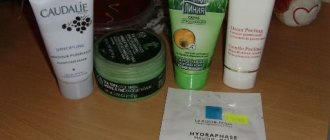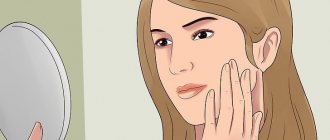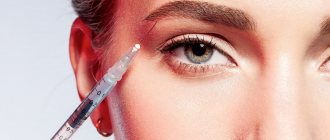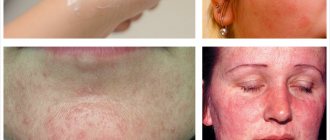The process of exfoliating keratinized particles of the epidermis from the surface of the skin using auxiliary products is called peeling. Chemical peeling occupies a special place in the classification of these procedures. It involves exposure to the surface of the face with specialized chemical compounds. As a result of this influence, the stratum corneum softens and is gently discharged along with dirt, bacteria and secretions of the sebaceous and sweat glands. Chemical facial peeling can be performed either in a salon or at home.
Superficial facial peeling is a fairly gentle procedure that does not affect the deeper layers of the skin.
Types of chemical peeling
Like other types of cleansing procedures, peeling with chemical products can have varying depths of impact. This principle allows us to distinguish three main types of cleaning: superficial, middle and deep.
- Superficial peeling exerts its effect within several layers of the epidermis, its horny part. This is the most gentle option for facial cleansing, often used even at home. The impact does not affect the usual rhythm of life. The main indication for the procedure is young problem skin. Superficial chemical peeling gives immediate results, but is not long-lasting. Cleansing courses must be repeated regularly.
- Medium peeling has a deeper effect. It affects the stratum corneum of the epidermis completely, the components reach the basement membrane. The procedure causes persistent facial redness and severe peeling. After the session, home treatment is required for at least one week. It is rarely performed at home: only by an experienced specialist for certain indications. In addition to solving skin problems, a chemical session has a lasting rejuvenating effect that lasts up to a year.
- Deep peeling causes rejection of the epidermis, even affecting the basement membrane. This kind of chemical peeling is not carried out at home, because it requires local or general anesthesia and is a deep chemical burn of the face. The rehabilitation period until the epidermis is completely restored can take about five months. The procedure is indicated for deep wrinkles, scars, scars.

If you have recently sunbathed on the beach or spent a lot of time in the sun anywhere else, chemical peeling is not yet possible.
Skin care after chemical peeling
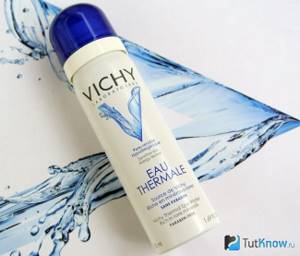
It is imperative to use special creams, balms and lotions prescribed by a specialist, which will allow the skin to recover as quickly as possible from traumatic exposure. As a rule, it is recommended to purchase post-peeling care cosmetics in the same salon where you had the peeling procedure. Despite the fairly high price of such products, their use will allow you to achieve the maximum effect from the procedure.
If you cannot afford expensive cosmetic care for injured skin, you can use Panthenol, Bepanten, which well moisturize and regenerate the epidermis.
Thermal water at room temperature also softens the skin and eliminates post-traumatic swelling. Products containing glycolic acid should be excluded from care products.
It is also extremely important to use sunscreens and balms with a factor of at least 30. Even in cloudy weather, it is necessary to apply the cream before leaving the house. Exposure to direct sunlight is strictly not recommended during the period of skin regeneration.
It is not allowed to remove crusts from the surface of the face on your own after peeling. This can cause scars or scars to form.
Indications and contraindications for the procedure
Among the main indications for chemical peeling are:
- care for problematic facial skin with acne, comedones and the consequences of violation of the integrity of the skin;
- pronounced hyperpigmentation of the epidermis;
- decreased skin tone and elasticity;
- age-related changes in the form of wrinkles, folds, sagging as a consequence of exposure to ultraviolet radiation or hormonal changes;
- small scars and the problem of ingrown hairs;
- increased fat content of the epidermis, enlarged pores, sebaceous plugs;
- unevenness and dull complexion of the skin due to thickening of the stratum corneum;
- preparation for more serious procedures in a salon or at home.
Chemical peeling of the face is not performed if:
- viral or infectious diseases in the acute stage;
- pregnancy, lactation;
- fresh tanning or recent anti-aging procedures;
- mental, somatic, oncological diseases;
- taking a number of medications;
- increased skin sensitivity;
- open wounds.
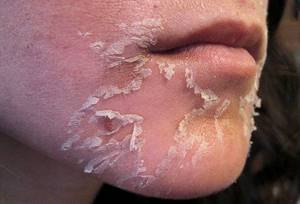
Chemical peeling is, in any case, a burn that leads to intensive renewal of one or several layers of skin
Peeling with calcium chloride
Performing a chemical peel at home using calcium chloride is a simple and inexpensive procedure, and the results are excellent. It will help get rid of blackheads, acne marks, freckles and age spots, skin unevenness and make it more delicate, elastic, complexion will become even and beautiful.
You will need calcium chloride - a 5% solution in ampoules, you can buy it at the pharmacy.
Peeling is performed as follows:
- You need to wash your face and cleanse your face with lotion or toner.
- Using a cotton pad, apply the calcium chloride solution to your face and leave until completely dry. Then you need to apply the next layer in the same way. There should be 4 layers in total (in subsequent sessions you can increase the number of layers, but not more than 8).
- Next, you need to soap your fingertips or a cotton pad with baby soap (without any additives). Lather your face with massage movements so that pellets form. The skin underneath becomes smooth and shiny.
- Then you need to remove all the pellets and wash with warm water. After the procedure, you can wipe your face with chamomile infusion or make a moisturizing banana mask.
This cosmetic procedure is quite effective and can be successfully used for normal, combination and oily skin. The result is visible after the first use. You can repeat the peeling after 7 days. The course consists of 4–5 sessions; after completing the full course, a break of 1–2 months is required.
How chemical peels work
Regardless of the composition, chemical facial peeling at home and in the salon works the same. As a result of applying the product to the surface of the epidermis, a reaction occurs and a chemical burn develops. In response to this, tissues begin to produce anti-inflammatory components, enzymes, and cells begin to actively divide. In the process of renewal of the stratum corneum, capillaries are formed, the synthesis of collagen and elastin is accelerated.
Old cells are replaced by new ones, the dermis thickens, the tissues become denser and stretched. Peeling leads to renewal of the epithelium, improvement of its appearance, disappearance of age spots, scars, stretch marks, post-acne. The face becomes fresh and smooth, its color is evened out. The work of the sebaceous glands is normalized, the acid-base balance of the skin returns to normal.
The use of any chemical peeling leads to drying of tissues; this must be taken into account when choosing recipes for preparing compositions at home.
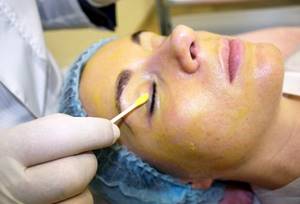
Application of acid is the main stage of chemical peeling of the face.
Home Recipes
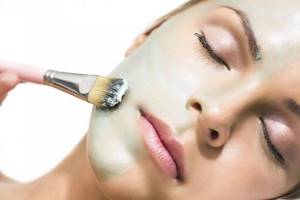
As agreed before, we provide recipes for chemical peeling of the face at home. Home remedies include ingredients that are either always on hand or can be easily purchased at a store, pharmacy, or market.
- "Fruit Paradise" Preparing the peeling composition is very simple. You need to use fruits with a high acid content: apricots, citrus fruits, kiwi, gooseberries, cherries, raspberries, currants, cranberries, lingonberries, strawberries. To make the procedure more effective, you can make a potion from several components. Just grind the selected ingredients into a paste and carry out the manipulation according to the above plan.
- Yogurt-lemon. This self-prepared chemical peeling will not only cleanse the skin of dead skin particles, but will also help cope with age spots. You need to take an equal amount of unsweetened fresh yogurt, lemon juice and cane sugar. Further everything is according to the standard.
- Calcium chloride. Do-it-yourself chemical peeling from a pharmaceutical preparation will have an amazing effect. The skin will become soft, smooth, tightened, fresh. But keep in mind that this is a mid-cleaning and you need to act very carefully. Apply the solution from the ampoule to the skin in several layers, and then use baby soap to roll it off along with dirt and other unnecessary particles.
- "Emergency help". You won’t be able to get a solution of salicylic acid in a pharmacy—it’s extremely difficult to find it in its pure form. But salicylic alcohol is commercially available. With its help you can get rid of acne, pimples, blackheads. But this is a slow and painstaking task. It is necessary to apply alcohol to problem areas using a cotton swab.
- Honey, lemon. Among cleansing compositions, honey-based products are especially popular. The bee product has bactericidal, nutritional and moisturizing properties. The simplest recipe is to mix equal amounts of honey and lemon juice. Apply the composition to a previously prepared face and leave for a quarter of an hour. Then rinse with water and apply moisturizer according to your skin type.
As you can see, there are many alternative natural remedies that are no less effective than professional ones. However, if there are serious problems, the help of a specialist is irreplaceable.
Stages of the procedure
If peeling is carried out in a salon, then pre-peeling preparation and intensive rehabilitation care are required. The procedure carried out at home is a more gentle cleansing option; its chemical composition is based on low concentration acids or enzymes, so the session is simple and does not require special skills.
Pre-peeling preparation is necessary in cases of significant thickening of the stratum corneum. In order to smooth it out and increase tissue permeability, a special chemical product or diluted fruit acid is applied to the skin for 1-2 weeks.
After preparation, chemical peeling is carried out directly. In the salon, the cosmetologist selects the type of acid or a combination of several components, their concentration, exposure time, and the number of layers applied. The mass is removed with a special neutralizer. At home, a weak soda solution can act as a neutralizer.
Post-peeling care allows you to avoid the development of complications and consolidate the results of the procedure. To speed up facial epithelization, soothing masks and moisturizing creams are recommended. The recipes for such products involve the use of natural ingredients and provide high efficiency. Another important point is that a chemical burn causes increased sensitivity of the epidermis to ultraviolet radiation, so the use of sunscreen products is mandatory.
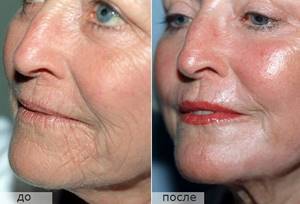
The degree of severity of the anti-aging effect depends on what acid was used for chemical peeling
Contraindications
Before doing homemade facial peeling, you need to consult a cosmetologist. The specialist will advise you on how to perform it correctly and not cause harm to the skin. It must be remembered that such cosmetic procedures are not suitable for everyone. Carrying out chemical peeling at home is unacceptable if:
Papaya, Honey and Pineapple at Home Chemical Saw
Later, gently warm the mixture over low heat, stirring frequently, until this gelatin is completely dissolved.
- Peel this cucumber, remove its seeds and then cut it into pieces.
- Place them in the same food processor and then wash thoroughly.
Homemade chemical peels are prepared with papaya and pineapple; they have natural enzymes as well as alpha hydroxy acids that remove dead skin cells.
Lemon and pomegranate at home Chemical saw
Generally speaking, the pomegranate in the natural chemical pill is loaded with powerful antioxidants. Peel half the pomegranate and cut the fruit into pieces and place them in one bowl or food processor.
Strawberries, grape juice, heavy cream and honey at home Chemical saw
Here's a recipe to do this at home chemical peel.
- there are inflammations and exacerbations of acne (except for salicylic peeling);
- there are lesions, wounds, burns on the skin;
- skin is too thin, dehydrated or irritated;
- there are infectious, oncological or other diseases or herpes in the active phase;
- increased temperature due to viral or respiratory diseases.
Contraindications also include cardiovascular and mental diseases, pregnancy and breastfeeding, as well as rosacea.
Natural DIY Chemical Peel
Heat the honey until it becomes liquid by placing it in a small metal bowl or glass that is submerged in hot water. Add the grapes and strawberries to the same food processor, then fill them with the same pulp. Add the cream and honey and mix until you have one nice smooth paste. Apply this paste carefully and evenly using a face brush or spatula onto your clean neck and face; keep your eye area clear. After this, wash it with warm water and finish with one cold; Pat skin dry using a clean towel. Some drops of thinner liquefier or ¼ teaspoon of powdered meat tenderizer1 or 1 tablespoon of non-flammable gelatin. After this, sprinkle cinnamon and butcher over this cucumber mixture and now stir well to combine. Finally, rinse off any residue and use a moisturizer if necessary.
Papaya and pineapple at home Chemical saw
Do not use more than once a week. Treat on the skin for 10 minutes and then wash it off with cleanser or water. Add aloe vera gel and cucumber juice. Refrigerate for about 25 minutes until the mixture begins to thicken. Apply this mixture to your face and neck and let it dry for about 20 minutes. Peel off the mask and rinse it with warm water.
- Then lie down, relax and let the mask sit for about 15 minutes.
- One small cucumber, seeded, plus puree.
- One cinnamon cinnamon handle if necessary.
- Place this cucumber in one medium bowl and then sprinkle with gelatin.
- Then add some water if it doesn't start to dissolve.
- This gelatin dissolves and also becomes paste-like.
- Papaya and pineapple puree in one blender or otherwise.
- Then add honey and now thoroughly.
- Rinse your face and then apply this mixture to your skin, avoiding the eye area.
- Leave on for 5 minutes, then rinse with cool water.
- After this, apply one moisturizer.
- Mix well until the mixture forms a puree.
- Then apply this mixture to your face, avoiding your vision area.
- This is a great mask to use once a week to clear your skin.
- Clean the cucumber until the mixture resembles one paste.
- Strain using a sieve and then reserve the juice.
- In one saucepan, combine chamomile tea, green tea and gelatin.
- Lower the temperature until it dissolves.
- Remove from heat and then pour into one glass bowl.
This at-home chemical peel gets rid of dead skin cells due to its papain enzyme.
If you have at least one of the above contraindications, then you cannot do chemical peeling.
Acids used for chemical exposure of the epidermis
Different acids provide different depths of action. Chemical phenol facial peeling provides the deepest impact. This type of cleansing is equated to surgery. In one procedure, at least 10 years of age are removed. Among the most popular intermediate-acting acids, experts highlight trichloroacetic and salicylic acids. You can look at photographs of such chemical peeling before and after the procedure - the difference in the condition of the skin is obvious.
Superficial chemical peeling at home and in beauty salons is most often carried out with fruit acids or calcium chloride. These components can be purchased in ready-made concentrated form or used in recipes based on natural ingredients.

In order not to expose yourself to unnecessary risks when carrying out home peeling, give preference not to pure acids, but to products containing them
Medium peeling
This type of chemical peel targets the deeper, epidermal layers of the skin. The active ingredient in this peeling is trichloroacetic acid, salicylic acid, or combined formulations (Jessner peels) are used.
Medium chemical peeling is primarily a salon procedure. However, it is possible to do such cleaning at home. Experts recommend this type of peeling to solve more severe skin problems:
- significant facial pigmentation, including age-related;
- problematic skin (chronic redness, ichthyosis, various keratoses, acne);
- scars, acne scars;
- medium depth wrinkles, crow's feet.
Medium chemical peeling at home is carried out with special care, since it is not easy for an untrained person to take into account the many factors that make this procedure safe. The main thing is to follow all measures at home and prevent complications.
Chemical peeling at home
Even if you decide to carry out chemical peeling at home, it is advisable to get a recommendation from a professional who will determine your skin type, advise on the best option for cleansing your face, and develop an individual daily care program. Many women, after undergoing procedures in a hospital setting, simply try to repeat the cosmetologist’s manipulations. Usually such experiments do not lead to anything good. When preparing and conducting home peelings, there are specific features that must be taken into account.
- Any peeling – mechanical, chemical or combined – is stressful for the body. It is necessary to set aside several hours of your time in order to prepare for the procedure, carry out the manipulation itself without haste, and provide the skin with subsequent proper rest.
- At home, it is better not to use pure acids. Replace them with safer ingredients. These can be fermented milk products, vegetables, fruits, wine, berries, nuts, essential oils.
- If, nevertheless, an acid is chosen as the main ingredient, it is important to remember that it must be neutralized before rinsing with water. Even a drop of water touching a surface treated with acid causes a chemical burn.
- Some manufacturers offer special kits that allow chemical peeling of the face. You just need to apply the prepared components to the skin. Such options may be optimal for skin care at home, but you should not use medications thoughtlessly. It is necessary to ensure that the components correspond to the type of epidermis.
- Even with a low concentration of active components and the presence of a softening base, peeling is a rather aggressive procedure; you should not abuse it.
- On the other hand, regular and proper peeling is an affordable way to preserve the beauty of your face and prolong its youth.
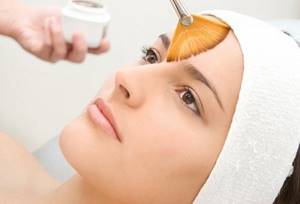
The calcium chloride solution should be applied to the face in layers.
Deep peeling
Deep peeling is the most radical procedure in which the effect of the drug extends deep into all layers of the dermis. The purpose of the operation is to completely replace old facial skin with younger tissue.
Phenol peeling or peeling with longer exposure of the skin to trichloroacetic acid is common. Such procedures are performed in a hospital setting under anesthesia. A severe burn to the face requires proper care and is equivalent to a surgical operation, so it is impossible to do deep peeling at home.
A deep type of peeling may be recommended to eliminate obvious skin problems:
- stretch marks;
- scars and deep wrinkles;
- various scars;
- Features of chemical peeling at home
The following products are used for chemical peeling:
- solutions of fruit or active acids;
- ready-made creams containing mixtures of fruit acids and additional components that anesthetize and moisturize the skin.
[adsense1]
IMPORTANT!
- Take a test for an allergic reaction, for which the composition is applied to the inside of the elbow. If after 5 minutes only a slight tingling sensation is felt, you can begin the procedure. A burning sensation or redness is a reason to refuse the procedure.
- Perform peeling only on cloudy days in autumn or winter, then carefully protect your facial skin from ultraviolet radiation.
- Do not use chemical peeling compounds in the area around the eyes.
- After peeling, follow the condition for 24 hours: do not touch your face with your hands, so as not to injure the skin.
Effective recipes for home peeling
A gentle procedure for removing rough skin and rejuvenating the face can be done at home using available products sold in pharmacies. Of course, you will not get such brilliant results as after visiting a salon. But if you regularly do chemical peeling at home, you can achieve skin renewal and smooth out wrinkles. Here are proven recipes for home use.
Peeling with calcium chloride
Perhaps the easiest and safest way to improve your appearance is superficial chemical peeling. For the first procedure, it is better to take a 5% solution of calcium chloride (sold in ampoules). Using a sponge, apply a calcium chloride solution to dry, cleansed skin and wait until the mixture dries. Apply another layer of the product on top and again allow time to dry. Such manipulations are performed at home from 4 to 8 times.
Hands are “soaped” with baby cream and carefully, using your fingertips, the mixture is removed by rolling it up. Horny particles will be rejected along with the chemical base. Rinse the facial skin generously with water.
After the procedure, facial redness and dry skin may appear. A mask with oatmeal, chamomile infusion and banana pulp will help restore them. All ingredients are mixed until pureed and applied to the face. Instead of a mask at home, you can use compresses with herbal decoctions - calendula, mint or sage, which will have an anti-inflammatory and soothing effect.
Although the procedure is considered quite mild, it should be carried out at home no more than once every 10 days.
Classic peeling
In a glass, mix 30 ml of camphor alcohol and glycerin, add 10 ml of ammonia (solution concentration - 10%), 2 tablets of hydroperite and 10 g of boric acid. In another container, grate good quality baby soap on a fine grater and gradually add the prepared chemical mixture until the mass reaches a creamy consistency. It is applied to the skin of the face and allowed to dry, after which it is washed off with calcium chloride at a 10% concentration. The face is washed generously with water and dried with a paper towel.
The mixture keeps well in the refrigerator for up to 3 months.
Chemical peeling with bodyaga
Bodyaga powder is mixed with 3% hydrogen peroxide until the mass begins to bubble and becomes a paste-like consistency. A mask with bodyaga is applied to the face, but the eyebrows are first lubricated with Vaseline to prevent their discoloration. Rubber gloves are put on your hands. Keep the mask on for 20 minutes.
Chemical peeling of the face with bodyaga at home is carried out daily until the skin begins to peel off. Usually, for normal and dry skin, you will need to make 2-3 masks, and oily skin will have to be treated for 4-5 days.
A mask with bodyaga has a rejuvenating effect.
Photos before and after chemical peeling
How to do chemical peeling - watch the video: Chemical peeling is a procedure that allows you to achieve significant rejuvenation of the skin and eliminate aesthetic imperfections. Exfoliation of the upper layer of the epidermis under the influence of acids triggers the natural processes of regeneration and restoration of firmness, elasticity and turgor of the skin.
Acids
Different acids have different effects on the skin and are used to eliminate various cosmetic defects.
Who are acid peels indicated for:
- persons with problem skin, both oily and dry;
- those who experience the first signs of skin aging: loss of firmness, elasticity, sagging skin, the appearance of the first shallow wrinkles;
- those who have freckles, pigmentation, uneven skin color;
- those with thick, bumpy skin;
- for those who have acne, pimples, acne and post-acne.
All acids do an excellent job of exfoliating the skin. Only some work with the stratum corneum of the epidermis (superficial peeling), while others penetrate deep into the skin (medium and deep peeling).
Salicylic acid
is the most famous and most commonly used component in cosmetics with a strong anti-inflammatory and anti-acne effect.
Azelaic acid
Suitable for sensitive skin with rosacea, excellent whitening.
Retinoic and glycolic acids
They perfectly cleanse the skin surface of dead epithelium and help accelerate facial skin renewal.
Lactic acid
is part of the surface moisturizing complex of the skin, so its moisturizing effect can be used to increase the level of hydration of dry skin. You can make excellent almond, glycolic, lemon and milk peels using home remedies.
Curious to know what trichloroacetic acid peeling is? Watch the video where you can familiarize yourself with the procedure in detail.
Read the description of the coral peeling procedure and post-peel skin care at home.
Description of the stages of the chemical peeling procedure
- After preliminary cleansing and degreasing the patient’s facial skin, the cosmetologist soaks a cotton swab in a chemical solution and then carefully squeezes it out. This is important to do in order to avoid getting the solution on the mucous membrane of the eye.
- Next, the solution is rubbed in with a cotton applicator for 30-60 minutes. The duration of the procedure is determined by changes in skin color. The specialist begins to treat the working surface from the forehead area. Then the solution is rubbed into the nose, cheeks and chin area. With special care, the acid mixture is applied to areas where wrinkles are present.
- The next stage of the procedure is to stick four layers of adhesive plaster of two types on the face: cotton (2 layers) and silk (2 layers). This action is explained by the need to maintain the appropriate concentration of the peeling solution on the facial skin for as long as possible. Thus, the duration of the procedure will be 1-2 hours. The resulting mask is not removed for two days, although already on the second day it comes off on its own.
- On the day of removing the patch mask, the cosmetologist treats the skin with thymol iodide, which ensures its regeneration. The duration of the procedure is 1-2 hours. After 7 days, the swelling decreases, and a dense crust appears on the face.
- Finally, the cosmetologist will cover the skin with a thick layer of ordinary cotton wool. The procedure time is 20-30 minutes. A day later, the cotton wool is removed from the face and then the patient can independently care for it using cosmetics recommended by the doctor.
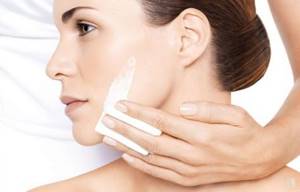
After a chemical peel, the patient's skin will feel like it has been sunburned, with redness and peeling lasting 3 to 14 days.
The patient experiences a slight burning sensation. The skin treated for one hour will develop quite severe swelling, making it almost impossible to open your eyes for the first two days.
